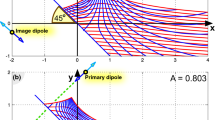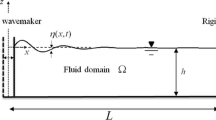Abstract
The inviscid free-surface flow due to an impulsive bottom flux on constant depth is investigated analytically and numerically. The following classes of two-dimensional flow are considered: an upwelling flow which is uniform over a half-plane, a line source/sink, and a dipole aligned along the bottom. The bottom flux is turned on impulsively and may decay with time. The fully nonlinear problem is solved numerically. A small-time asymptotic expansion to third order is found for the nonlinear problem. An asymptotic large-time solution is found for the linearized problem. A steady source will generate a pair of symmetric bores, and their breaking is investigated. A steady sink generates a depression wave if it is weak, and dip instability if it is strong. Wave breaking will occur for intermediate sink strengths. A decaying source emits solitary waves.
Similar content being viewed by others
References
H. Lamb, Hydrodynamics. New York: Dover (1932) 738pp.
J.V. Wehausen and E.V. Laitone, Water waves. In: W. Flugge (ed.) Handbuck der Physik (Vol. 9).Berlin: Springer (1960) pp. 446–778.
G.B. Whitham, Linear and Nonlinear Waves. New York: J. Wiley (1974) 636pp.
C.C. Mei, The Applied Dynamics of Ocean Surface Waves. Singapore: World Scientific (1983) 740pp.
J.L. Hammack, A note on tsunamis: their generation and propagation in an ocean of uniform depth. J. Fluid Mech. 60 (1973) 769–799.
D.H. Peregrine, Calculations of the development of an undular bore, J. Fluid Mech. 25 (1966) 321–330.
A.F. Teles da Silva and D.H. Peregrine, Nonsteady computations of undular and breaking bores. In: Proc. 22nd Int. Conf. Coastal Engng., Delft. A.S.C.E. 1 (1990) 1019–1032.
P.A. Tyvand, Unsteady free-surface flow due to a line source Phys. Fluids A4 (1992) 671–676.
M.J. Kim, Numerical study of dip formation using sink array model. Int. J. Modern Phys. C8 (1997) 1249–1262.
T. Miloh and P.A. Tyvand, Non-linear transient free-surface flow and dip formation due to a point sink. Phys. Fluid00s A5 (1993) 1368–1375.
M. Xue and D.K.P. Yue, Nonlinear free-surface flow due to an impulsively-started submerged point sink. J. Fluid Mech. 364(1998) 325–347.
D.H. Peregrine, Flow due to a vertical plate moving in a channel. Unpublished note (1972).
M. Greenhow and W.-M. Lin, Nonlinear free surface effects: experiments and theory. Report 83–19. MIT, Dept. of Ocean Engineering (1983).
P.A. Tyvand and A.R.F. Storhaug, Green functions for impulsive free-surface flows due to bottom deflections in two-dimensional topographies. Phys. Fluids 12 (2000), 2819–2833.
P.A. Tyvand and M. Landrini, Free-surface flow of a fluid body with an inner circular cylinder in impulsive motion. J. Eng. Math. (2000) to appear.
P. Bassanini, C.M. Casciola, M.R. Lancia and R. Piva, A boundary integral formulation for kinetic field in aerodynamics. Part I: Mathematical analysis. Part II: Applications to unsteady 2D flows. Eur. J. Mech. B/Fluids 10 (1991) 605–627 and 11 (1992) 69-92.
A. Sidi and M. Israeli, Quadrature methods for periodic singular and weakly singular Fredholm integral equations.J. Sci. Comp. 3 (1988) 201–231.
P. Sonneveld, CGS, A fast Lanczos-type solver for nonsymmetric linear systems. SIAM J. Sci. Stat. Comp.10 (1989) 36–52.
G. Graziani and M. Landrini, Application of multipoles expansion technique to two-dimensional nonlinear free surface flows. J. Ship Res. 43 (1999) 1–13.
M.S. Longuet-Higgins and E.D. Cokelet, The deformation of steep surface waves on water. I A numerical method of computation. Proc. R. Soc. London A 350 (1976) 1–26.
J.W. Dold, An efficient surface integral algorithm applied to unsteady gravity waves. J. Comp. Phys. 103(1992) 90–115.
M. Abramowitz and I.A. Stegun, Handbook of Mathematical Functions. New York: Dover (1965) 1046pp.
T.B. Benjamin and M.J. Lighthill, On cnoidal waves and bores. Proc. R. Soc. London A224 (1954) 448–460.
A.J. Koerber and L.K. Forbes, Cusp flows due to an extended sink in two dimensions. J. Eng. Math. 36 (1999) 349–360.
B.T. Lubin and G.S. Springer, The formation of a dip on the surface of a liquid draining from a tank. J. Fluid Mech. 29 (1967) 385–390.
Q.-N. Zhou and W.P. Graebel, Axisymmetric draining of a cylindrical tank with a free surface. J. Fluid Mech. 221 (1990) 511–532.
M.S. Longuet-Higgins and H.N. Oguz, Critical jets in surface waves and collapsing cavities. Phil. Trans. R. Soc. London A 355 (1997) 625–639.
Author information
Authors and Affiliations
Rights and permissions
About this article
Cite this article
Landrini, M., Tyvand, P. Generation of water waves and bores by impulsive bottom flux. Journal of Engineering Mathematics 39, 131–170 (2001). https://doi.org/10.1023/A:1004857624937
Issue Date:
DOI: https://doi.org/10.1023/A:1004857624937




